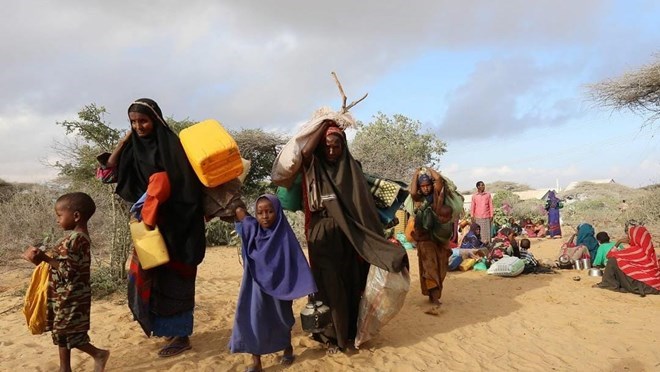
Saturday April 23, 2022

United Nations partners are taking a different approach to
famine prevention in Somalia: focusing on collaboration with local authorities
and communities in at-risk areas, UN humanitarians said on Friday.
"In 2016/2017, a similar shift coupled with timely and
scaled up humanitarian assistance averted famine in Somalia," the UN
Office for the Coordination of Humanitarian Affairs (OCHA) said.
"As the drought in Somalia continues to deteriorate the
country faces the risk of famine in six areas through June 2022 if the April to
June 'Gu' season rains fail as forecast, food prices continue to rise, and
humanitarian assistance is not scaled up," the office said. The number of
people affected by extreme drought is up from 4.9 million in March to 6.1
million in April. The search for water, food and pasture displaced about
759,400 people.
The Ukraine conflict helps hike food prices.
The office said that up to 90 percent of the water sources
across Somalia are drying up, including the Shabelle and Juba rivers. Water
levels are below historic minimum levels. An estimated 3.5 million people lack
sufficient access to water.
Hunger is rising, with more than 6 million Somalis now
facing severe food shortages from April through mid-2022, with an Integrated
Food Security Phase Classification (IPC) of 3 or higher, OCHA said. Acute
malnutrition in children is on the rise, reaching catastrophic levels in some
districts in southern Somalia.
It said that some 1.4 million children face acute
malnutrition this year, and 45 out of 74 districts have global acute
malnutrition rates of above 15 percent.
Lack of access to timely and adequate health care and
insufficient access to clean water, food and nutrition have contributed to a
spike in preventable diseases, OCHA said. Since January, authorities confirmed
more than 3,675 cases of acute watery diarrhea/cholera and 2,720 cases of
measles, increasing new admissions.
The office said drought disrupted school attendance for 1.4
million children in Somalia, of whom 420,000 are at risk of dropping out. About
45 percent of the students are girls.
Since January, humanitarian partners have reached almost 2.6
million people in Somalia with lifesaving assistance, including cash assistance
and vouchers, OCHA said. The 2022 Humanitarian Response Plan has received only
66.7 million U.S. dollars of the 1.5 billion dollars required. That's only 4.6
percent.
It said the UN Central Emergency Response Fund (CERF)
allocated 14 million U.S. dollars for the Somalia response, and the Somalia
Humanitarian Fund allocated 20 million dollars. The funding brings total CERF
funding for the drought response in Somalia to 66 million dollars since early
2021.
The OCHA said the drought risks becoming one of the worst
climate-induced emergencies in the Horn of Africa's recent history. "This
is one of the most severe La Nina-induced droughts in recent memory in the Horn
of Africa, leaving 15-16 million people across the Horn of Africa facing high
levels of acute hunger."
Last week, the UN World Meteorological Organization said,
"Eastern Africa is facing the very real prospect that the rains will fail
for a fourth consecutive season, placing Ethiopia, Kenya, and Somalia into a
drought of a length not experienced in the last 40 years." Enditem